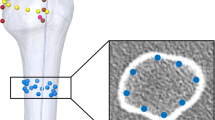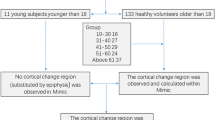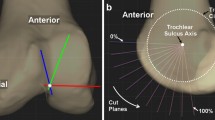Abstract
The supratrochlear aperture (STA) is a perforation of the septum between the olecranon and coronoid fossae of the humerus. Bones with STA are prone to supracondylar fractures and are thought to have narrower medullary canals. Our aim was to explore the relationship of the STA with medullary canal width and humeral size. The study employed a case–control research design with approximately equal numbers of individuals with and without STA from South African Whites, Blacks, and the Mixed ethnic group. Radiographs were taken anteroposteriorly using a Lodox Statscan and Image J® software was used to acquire measurements from the radiographs. In the proximal diaphysis, the mean medullary canal width was significantly smaller for STA humeri (13.59 vs. 14.72 mm). The same was true for the midshaft (10.21 vs. 10.84 mm) and the distal portion (10.05 vs. 10.63 mm). While STA humeri appeared to have narrower medullary canal dimensions, this was not the case after standardizing for bone size. The smaller medullary canal width reported in the literature for STA-bearing humeri is, therefore, due to bone size differences and not STA presence. This is supported by the strong positive correlation between bone size and medullary canal width irrespective of STA status. Thus, the medullary canal width increases with bone size independent of STA status. We, therefore, propose that bone size, and not STA presence, is the major factor to consider when choosing rods for intramedullary fixation.





Similar content being viewed by others
References
Akagi R, Takai Y, Kato E, Wakahara T, Ohta M, Kanehisa H, Fukunaga T, Kawakami Y (2010) Development of an equation to predict muscle volume of elbow flexors for men and women with a wide range of age. Eur J Appl Physiol 108:689–694. doi:10.1007/s00421-009-1269-1
Benfer RA, McKern TW (1966) The correlation of bone robusticity with the perforation of the coronoid-olecranon septum in the humerus of man. Am J Phys Anthropol 24:247–252
Bronner F, Farach-Carson M (2004) Bone formation. Topics in bone biology, vol 1. Springer, London, New York
Cauley JA, Lui LY, Ensrud KE, Zmuda JM, Stone KL, Hochberg MC, Cummings SR (2005) Bone mineral density and the risk of incident nonspinal fractures in black and white women. JAMA 293:2102–2108. doi:10.1001/jama.293.17.2102
Christos P, Marios P, Apostolos S (2011) Rare cases of humerus septal apertures in Greeks. Trends Med Res 6:178–183
Dayal MR, Kegley AD, Strkalj G, Bidmos MA, Kuykendall KL (2009) The history and composition of the Raymond A. Dart collection of human skeletons at the University of the Witwatersrand, Johannesburg, South Africa. Am J Phys Anthropol 140:324–335. doi:10.1002/ajpa.21072
Glanville EV (1967) Perforation of the coronoid-olecranon septum. Humero-ulnar relationships in Netherlands and African populations. Am J Phys Anthropol 26:85–92
Hirsh IS (1927) The supratrochlear foramen: clinical and anthropological considerations. Am J Surg 2:500–505
Keating J (2013) Fracture management. Textbook of orthopaedics, trauma and rheumatology, 2nd edn. Mosby, Toronto
L’Abbe EN, Loots M, Meiring JH (2005) The Pretoria bone collection: a modern South African skeletal sample. Homo 56:197–205
Laval-Jeantet AM, Bergot C, Carroll R, Garcia-Schaefer F (1983) Cortical bone senescence and mineral bone density of the humerus. Calcif Tissue Int 35:268–272. doi:10.1007/BF02405044
Leonard MB, Elmi A, Mostoufi-Moab S, Shults J, Burnham JM, Thayu M, Kibe L, Wetzsteon RJ, Zemel BS (2010) Effects of sex, race, and puberty on cortical bone and the functional muscle bone unit in children, adolescents, and young adults. J Clin Endocrinol Metab 95:1681–1689. doi:10.1210/jc.2009-1913
Mays S (1996) Age-dependent cortical bone loss in a medieval population. Int J Osteoarchaeol 6:144–154. doi:10.1002/(SICI)1099-1212(199603)6:2<144:AID-OA261>3.0.CO;2-G
Meiring RM, Avidon I, Norris SA, McVeigh JA (2013) A two-year history of high bone loading physical activity attenuates ethnic differences in bone strength and geometry in pre-/early pubertal children from a low-middle income country. Bone 57:522–530. doi:10.1016/j.bone.2013.08.027
Nayak SR, Das S, Krishnamurthy A, Prabhu LV, Potu BK (2009) Supratrochlear foramen of the humerus: an anatomico-radiological study with clinical implications. Ups J Med Sci 114:90–94. doi:10.1080/03009730802688819
Ndou R, Schepartz LA (2016) Morphometric characteristics of the humerus and ulna in limbs bearing the supratrochlear aperture (STA). Anat Rec (Hoboken) 299:220–233. doi:10.1002/ar.23294
Ndou R, Smith P, Gemell R, Mohatla O (2013) The supratrochlear foramen of the humerus in a South African dry bone sample. Clin Anat 26:870–874. doi:10.1002/ca.22132
Paraskevas GK, Papaziogas B, Tzaveas A, Giaglis G, Kitsoulis P, Natsis K (2010) The supratrochlear foramen of the humerus and its relation to the medullary canal: a potential surgical application. Med Sci Monit 16:BR119–BR123
Parfitt AM (1984) Age-related structural changes in trabecular and cortical bone: cellular mechanisms and biomechanical consequences. Calcif Tissue Int 36(Suppl 1):S123–S128. doi:10.1007/BF02406145
Pearson OM, Lieberman DE (2004) The aging of Wolff’s “law”: ontogeny and responses to mechanical loading in cortical bone. Am J Phys Anthropol Suppl 39:63–99. doi:10.1002/ajpa.20155
Sahajpal DT, Pichora D (2006) Septal aperture: an anatomic variant predisposing to bilateral low-energy fractures of the distal humerus. Can J Surg 49:363–364
Stull KE, L’Abbé EN, Steiner S (2013) Measuring distortion of skeletal elements in Lodox Statscan-generated images. Clin Anat 26:780–786. doi:10.1002/ca.22225
Thandrayen K, Norris SA, Pettifor JM (2009) Fracture rates in urban South African children of different ethnic origins: the birth to twenty cohort. Osteoporos Int 20:47–52. doi:10.1007/s00198-008-0627-x
Vidulich L, Norris SA, Cameron N, Pettifor JM (2006) Differences in bone size and bone mass between black and White 10-year-old South African children. Osteoporos Int 17:433–440. doi:10.1007/s00198-005-0004-y
Acknowledgments
We thank Nafeesah Karriem for permission to use the Lodox scanner and providing technical assistance at the University of Cape Town and Professor Wadee for permission to use the Lodox facility at the Department of Forensic Pathology, Stellenbosch University. We are very grateful to the following people for access to skeletal material: Brendon Billings for access to the Raymond A Dart Collection of Human Skeletons, Mandi Alblas for use of the University of Stellenbosch Bone Collection, Professor Alan Morris for use the University of Cape Town Bone Collection, and Professor Ericka L’Abbé and Marius Loots for use of the Pretoria Bone Collection. We thank Dr. T Esan for advice on statistical methods. Funding for the project came from the National Research Foundation (South Africa).
Author information
Authors and Affiliations
Corresponding author
Ethics declarations
Ethics
Ethical clearance (W-CJ-140604-1) under the South African Human Tissue Act No. 65 of 1983 and the National Health Act No. 61 of 2003 applies for use of the skeletal elements in the present study.
Conflict of interest
All the authors declare no financial relationship with the sponsor.
Rights and permissions
About this article
Cite this article
Ndou, R., Maharaj, S. & Schepartz, L.A. A radiographic investigation of the relationships between humeral cortical bone thickness, medullary canal width and the supratrochlear aperture (STA). Surg Radiol Anat 39, 57–68 (2017). https://doi.org/10.1007/s00276-016-1701-2
Received:
Accepted:
Published:
Issue Date:
DOI: https://doi.org/10.1007/s00276-016-1701-2




